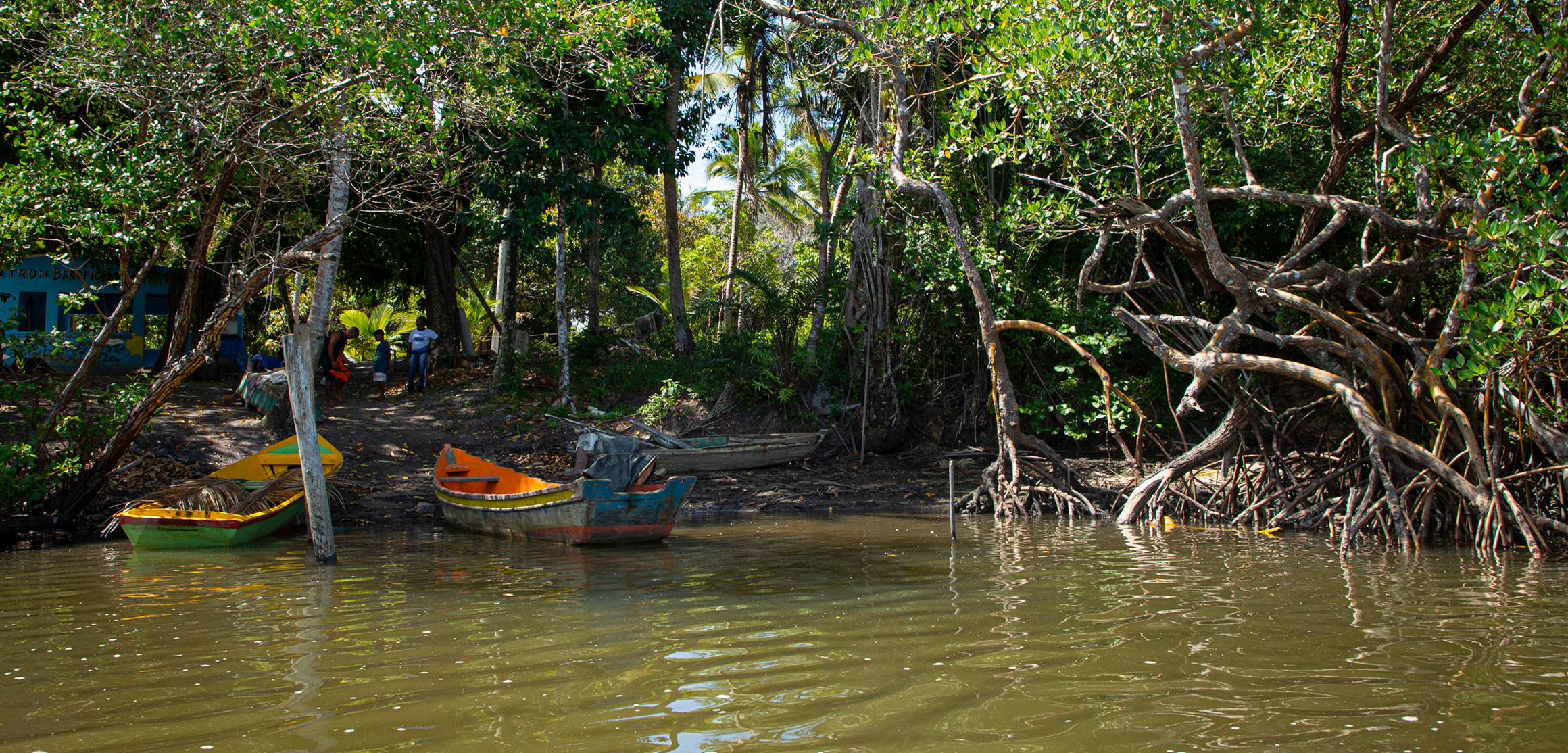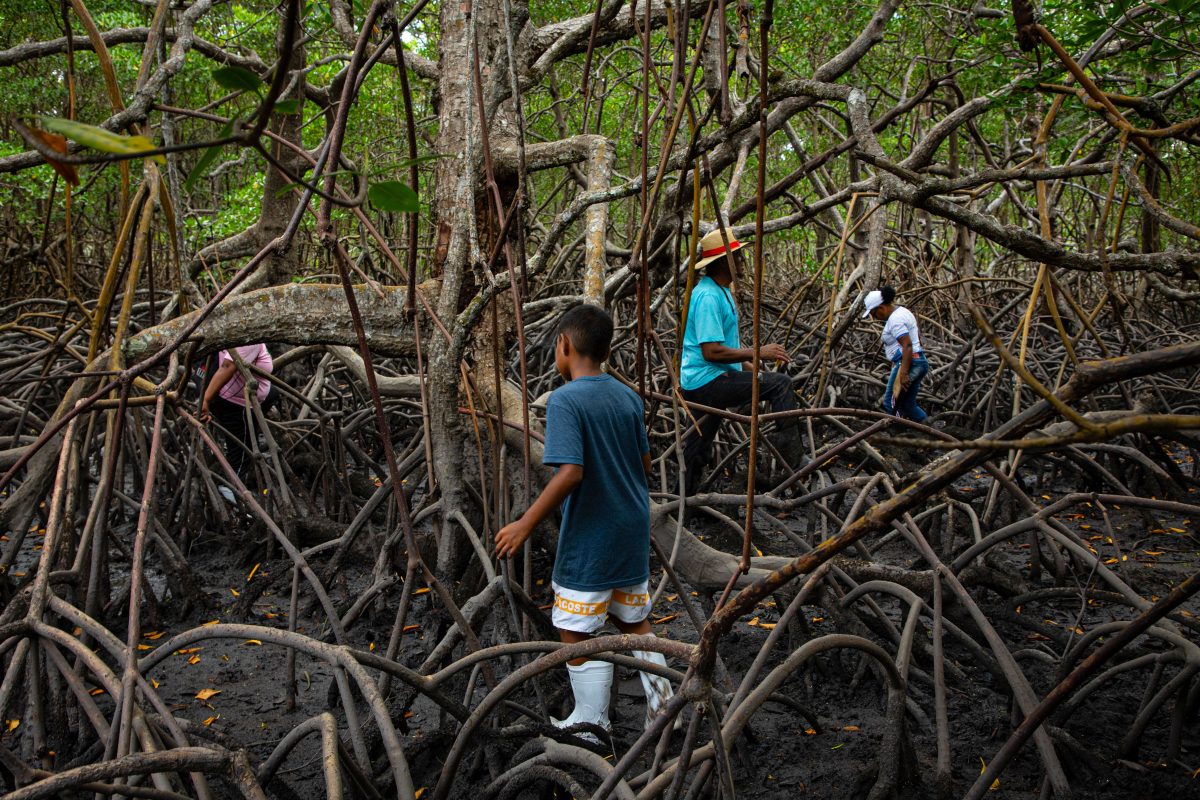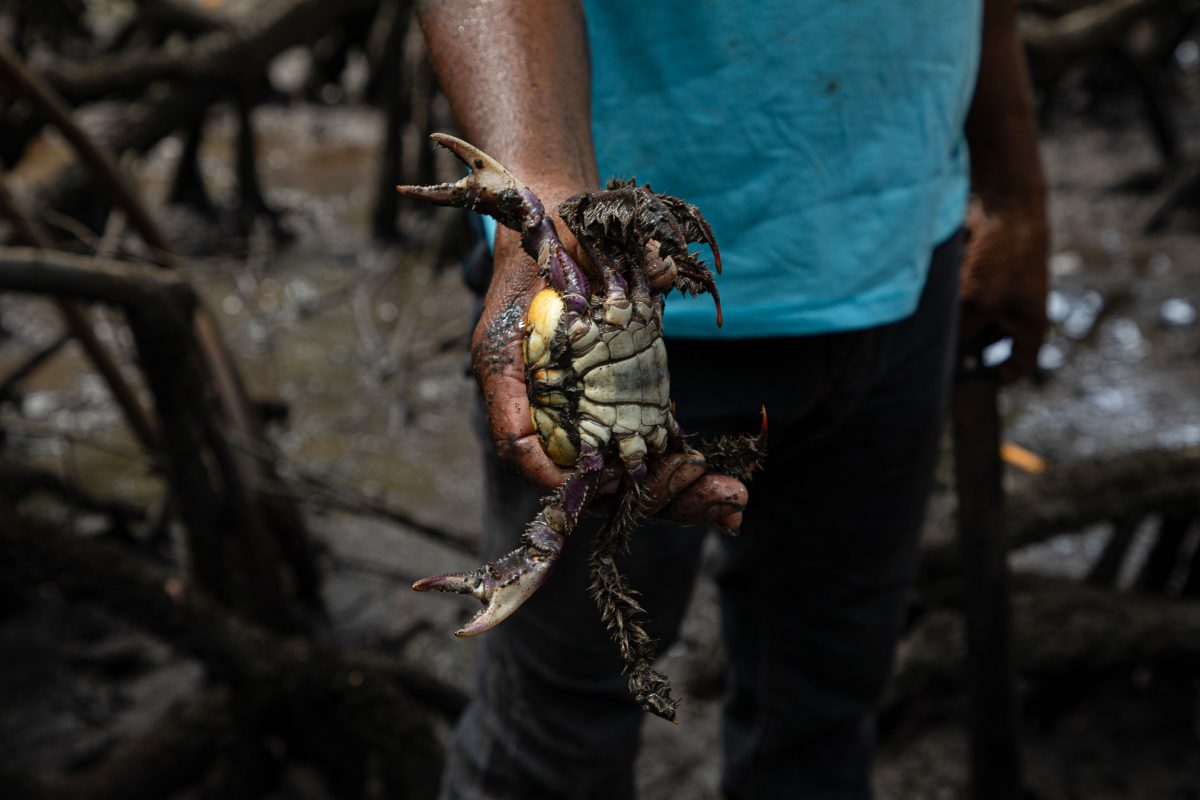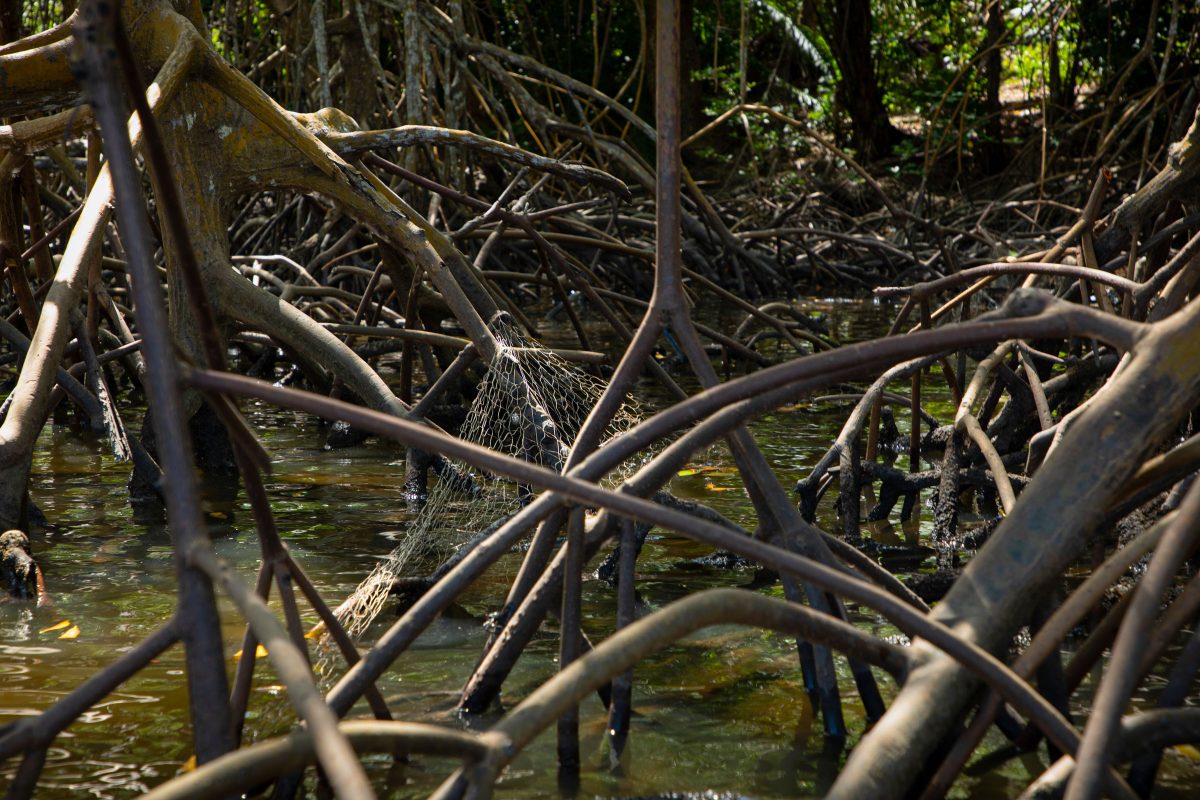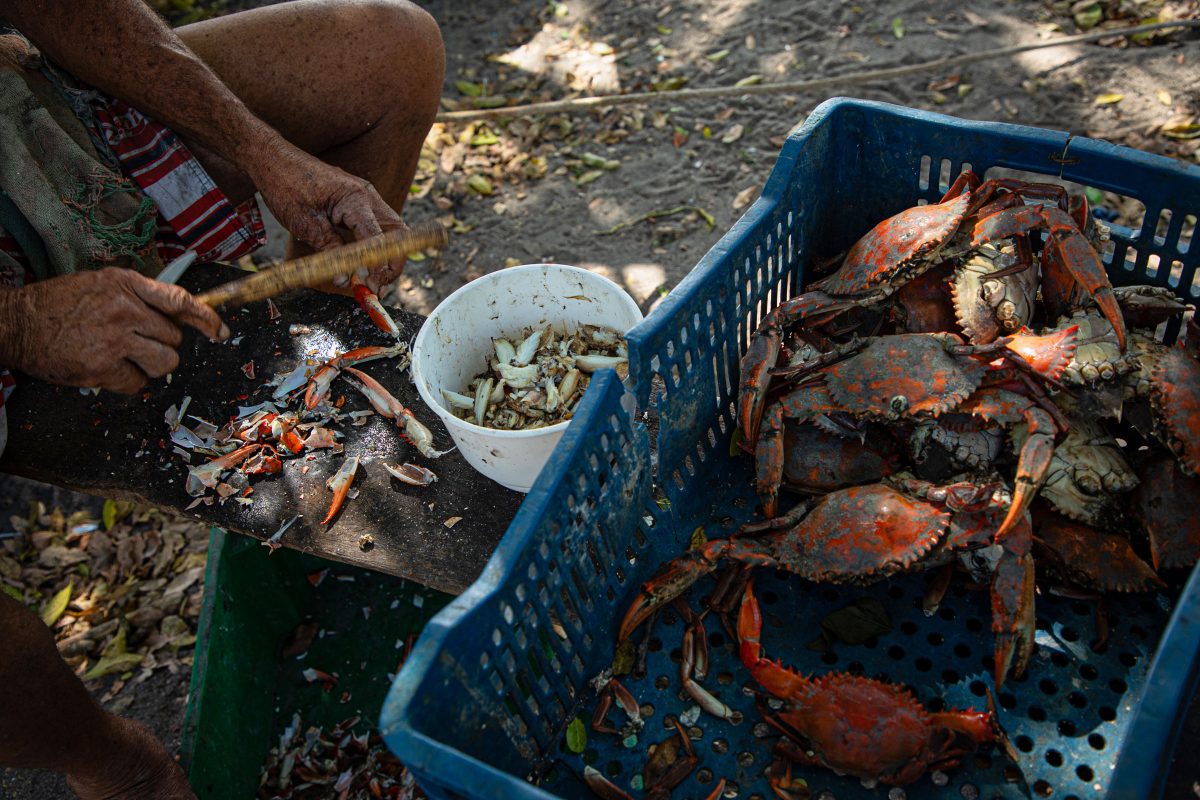Give a Village a Mangrove
To protect their mangrove forests and livelihoods, traditional communities in coastal Brazil set their hopes on small-scale tourism.
Article body copy
This story originally appeared in bioGraphic, an independent magazine about nature and regeneration powered by the California Academy of Sciences.
A small wooden boat creaks and sputters smoke as it pulls out of the dock in Caravelas, a town on the banks of a river that bears the same name in southern Bahia, Brazil. Rubens Menezes de Souza stands in the stern with his son, looking at the row of brightly painted houses that line the dock of the sleepy, 20,000-resident community.
He gestures at a straggle of brown branches, each the thickness of a large man’s arm, that push against the concrete promenade that separates houses from ocean. “Caravelas was built on top of mangroves,” he says. “They had to clear them all away to build the town.”
Just out of sight downstream, the river opens into the Atlantic Ocean, forming a 2.4-kilometer-long sandbar where its turbid, brown waters disappear into a crystalline blue sea. Most boats leaving Caravelas head that way, bound for the islands of Abrolhos about 65 kilometers offshore. The archipelago is a humpback whale breeding ground and a renowned diving spot, and a small tourism industry ferries visitors there to watch whales and scuba-dive. But we veer upriver, a lone vessel bound toward a labyrinth of estuary islands covered in mangrove forest.
From our boat, the individual mangrove trees seem to blend together—a continuous mat of glossy green leaves rising above a tangle of spidery roots that scuttle over and around each other before plunging into the river. We glide past them. No sign marks the place where we cross into the Cassurubá Extractive Reserve, which spans 100,000 hectares of estuary and islands.
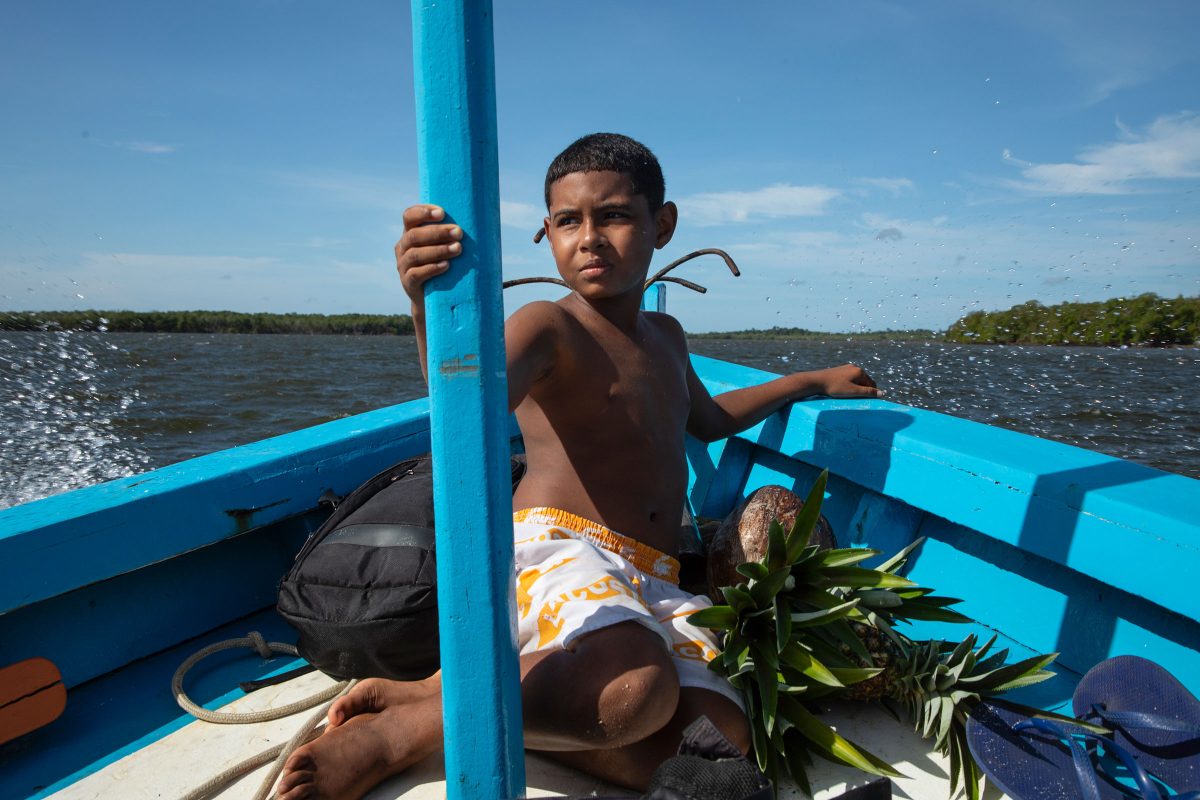
Rubens Menezes de Souza’s son sits at the bow of the family boat on a journey from Caravelas, Brazil, to the nearby Cassurubá Extractive Reserve.
Extractive reserves are a common type of protected area in Brazil; they conserve the landscape while allowing communities to continue sustainably harvesting their resources. Around 300 families, known as ribeirinhos—or river people—live in 28 villages inside the reserve; another 2,000 families live nearby. Together, they comanage the area with government agencies and have exclusive rights to harvest crabs and shellfish and carry out small-scale agriculture. Their dependence on the natural abundance binds them intimately to the reserve’s 11,000 hectares of mangroves.
The mangroves, in turn, play an essential role in the larger ecosystem. Those in Cassurubá are part of what some researchers and conservationists refer to as the Abrolhos seascape: a network of coral reefs and mangrove forests that harbors some of the highest-known marine biodiversity in the South Atlantic. The mangroves’ leggy roots trap sediment that otherwise would smother coral reefs, and they absorb nutrients that could disturb the estuary’s delicate chemical balance. The trees’ roots and shoots form a natural net that protects breeding sharks and small fish from larger predators and storms. They also protect against coastal erosion and store large amounts of carbon. Brazil alone hosts around 10 percent of the world’s mangrove forests, which in turn store up to eight percent of global carbon in their tissues and the soils they anchor. Yet as rising seas from climate change submerge some mangroves and others fall to development, stands like those in Cassurubá grow more precious.
Menezes de Souza helped organize the people who rely on these mangroves to fight for the creation of the Cassurubá Extractive Reserve in the early 2000s. Though they ultimately succeeded, the designation depends on fishermen remaining here and continuing their traditional livelihoods, and the reserve can be a hard place to stay. There’s no electricity, no plumbing, no medical facilities, and scant basic infrastructure, making it unattractive for many young people and difficult for aging older generations.
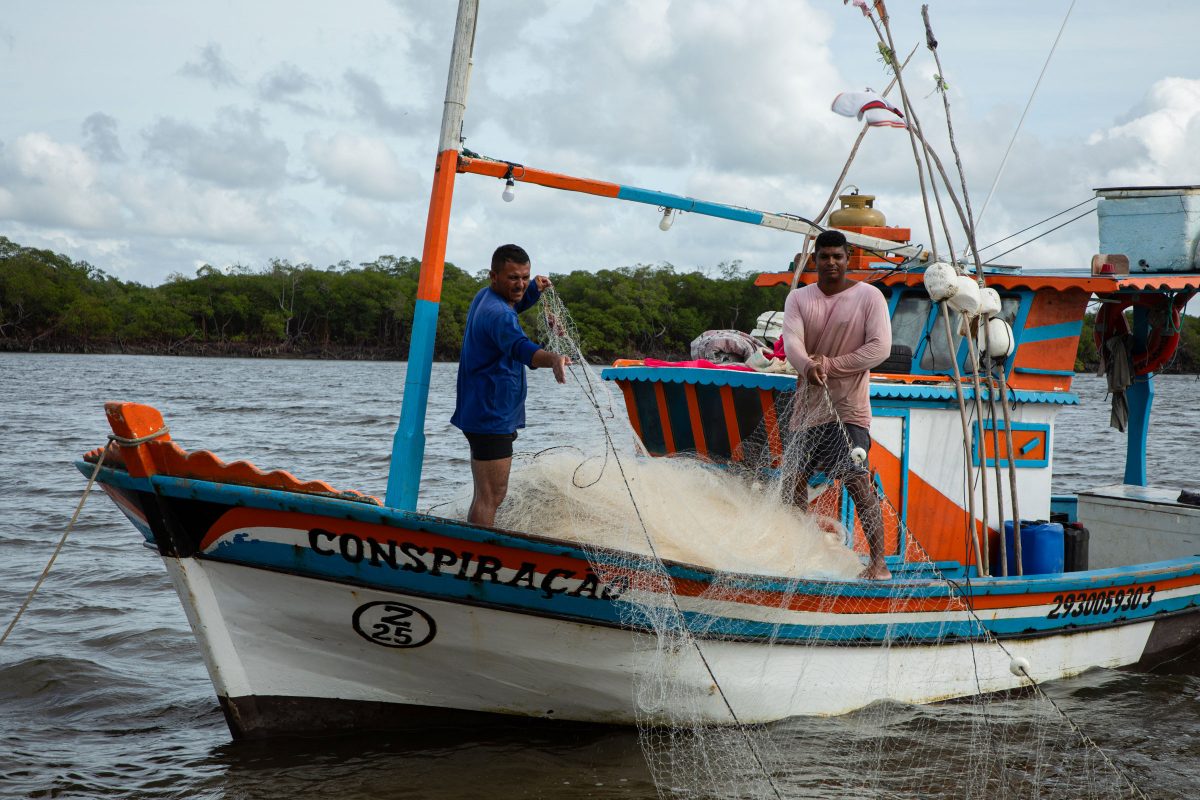
Mangroves provide a nursery ground for many marine species, helping ensure the estuary within the Cassurubá Extractive Reserve remains an abundant fishing ground for locals.
To try to ensure the survival of both his community and the reserve, Menezes de Souza has embarked on a new mission in his role as president of the residents’ association of the reserve villages of Tapera and Miringaba. He’s working to bring community tourism to the mangroves, with the hope that it will provide more enticing and diverse employment opportunities while also attracting needed services. “It’s always a process, always a struggle,” he tells me in Portuguese. “But now the territory belongs to us, and we need to think about not just the present but also the future.”
Brazil’s approach to community-led conservation is already progressive. If Menezes de Souza’s initiative succeeds, though, it will suggest another way that traditional communities can maintain control over their territory—and preserve the environments that their livelihoods and cultures depend on.
The driver beaches our boat on a small patch of sand near the villages of Tapera and Miringaba, each a handful of basic houses hunkering among mangroves. Three local tour guides greet us and lead us about a kilometer and a half overland into the mangrove forest. Once under the canopy, the wind dies. Branches dapple the light, and the air thickens with humidity. The trees spend half their time partially submerged, their spongy, hairy bark defending against both acidic mud and brackish water. When the tide recedes—as it has now—it leaves the mangroves standing in a thick, sulfurous-smelling muck. As we slog along in gumboots, gases from decomposing organic matter release a smell like rotting eggs.
Menezes de Souza, his son, and I follow the tour guides who step over and under branches with spry agility while carrying machetes for hacking through vegetation and harvesting food, along with steel rods for flushing crabs out of their burrows. The main sound, aside from the sucking steps of our boots, is that of scuttling crabs. Everywhere I look, crabs of different sizes and colors flee from our path, disappearing among roots or climbing up trunks. One of the guides, Genilson da Conceiçao Batista, a tall, wiry 64-year-old with a faint gloss of white over his irises, reaches out to pinch a few small red crabs off one tree, letting them run over his hand.
“We use these ones for bait,” da Conceiçao Batista tells me. “The bigger ones we eat.” He finds a burrow in the mud and plunges his arm in, up to his shoulder, pulling out a yellow crab the size of his fist, its claws pinching wildly. “It’s fierce,” he warns, passing it to me with the skill of someone who’s handled such creatures all his life. I grasp the crab’s back tightly, feeling the strength of its struggle, then hand it back. Da Conceiçao Batista grew up on this island. From the age of five, he’d trail behind his father and grandfather when they went out to harvest crabs to sell at local markets. He learned how to read the tides and the cycles of the moon and what time of year to harvest different crabs so as to not interfere with their breeding cycles.
Da Conceiçao Batista names each as he picks them up. The bait crabs he plucked from the trunk are aratú (Goniopsis cruentata), and the yellow crab with fierce pincers is uçá (Ucides cordatus). We find siri azul (Callinectes sapidus), a striking blue crab with a narrow body and spindly legs, and many small chama-maré, an umbrella term for the eight species of fiddler crab found in the mangroves. There are also sarará, which refers to three types of terrestrial crabs found at the outer edge of the mangrove forests, and the endangered guaiamum (Cardisoma guanhumi).
The Cassurubá reserve is one of the few areas where the Brazilian government allows people to harvest guaiamum, because population levels here can be sustainably managed and monitored. While Brazil’s marine extractive reserves remain understudied, residents and local biologists say that, anecdotally, numerous species of shrimp, fish, and other marine animals have also remained abundant in the reserve; this aligns with studies that increasingly show that biodiversity tends to be better-preserved in places where Indigenous and local communities own or manage the land.
The extractive reserve model was pioneered by famous activist and union leader Chico Mendes. In the 1970s and ’80s, Mendes fought to protect part of the Amazon rainforest that was crucial to his traditional community of rubber tappers, who needed intact forest to continue small-scale rubber harvesting. He proposed what was then a radical idea. Rather than protecting forests by excluding people, governments could share management with communities that had been sustainably harvesting forest products for generations and give them sole rights to use the land. Mendes didn’t live to see his idea reach fruition; a neighboring landowner assassinated him in 1988. Two years later, the Brazilian government created the first extractive reserve in the area Mendes had fought for and named it after him.
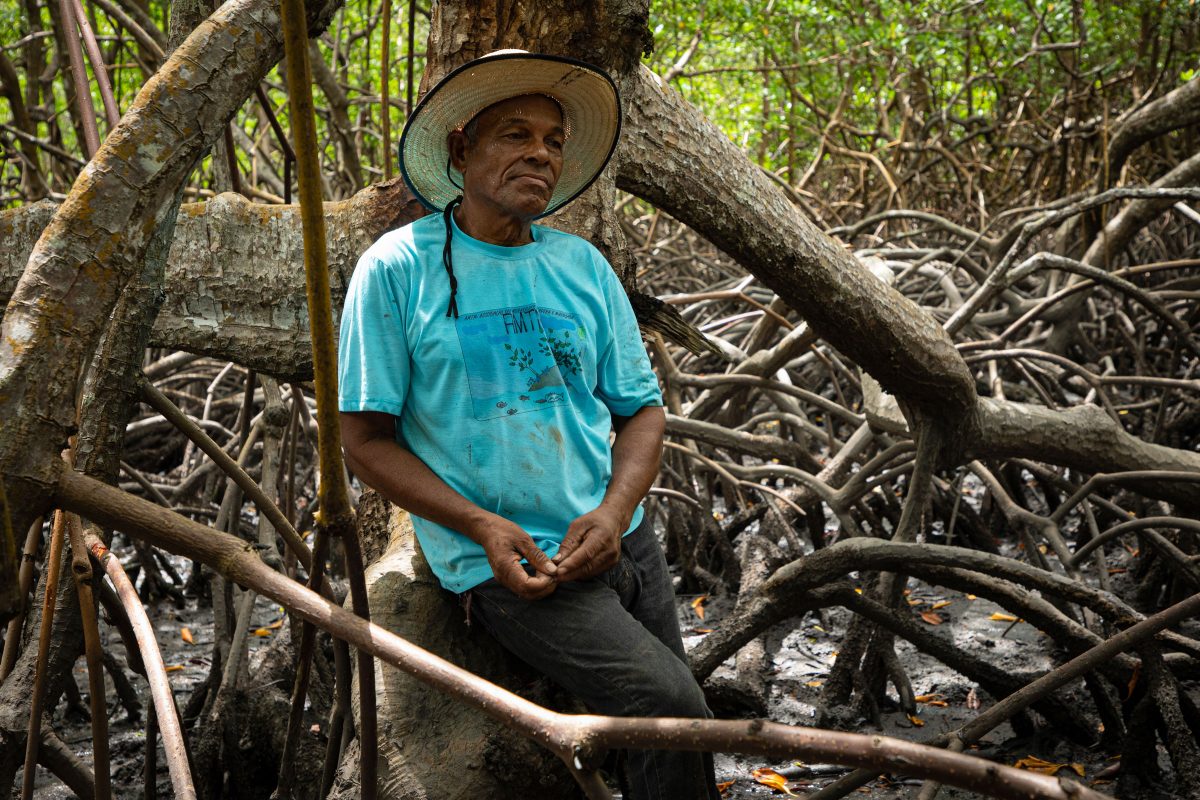
Da Conceiçao Batista has been sustainably harvesting crabs and other mangrove-dwelling species since he was a child.
Initially restricted to forests, the designation was later applied to other ecosystems, including marine environments. In total, the Brazilian government has created almost 100 extractive reserves, comanaged by the traditional communities, local governments, NGOs, and the Brazilian Ministry of the Environment. The reserves protect around 16 million hectares of land and ocean. Community members largely monitor the reserve and report conflicts and violations to the Chico Mendes Institute for Biodiversity Conservation (ICMBio), a federal agency linked to the Ministry of the Environment, only when necessary.
Because the reserves prohibit large industries from exploiting the resources within their borders, creating them can be a long and contentious process. The Cassurubá reserve was no exception. In 2004, shrimp farmers set their sights on the Caravelas River estuary to construct the largest shrimp farming area in Brazil. To develop shrimp farms, aquaculturists cut square sections from the mangroves or the salt pans behind the mangroves—known in Brazil as apicum—to breed and grow shrimp. Not only does this destroy mangrove trees directly, but the farms also produce effluent and change the nutrient balance in the water, degrading the surrounding mangroves and larger environment.
Like most local fishermen in the estuary, Menezes de Souza didn’t realize the scale of the threats at first. The shrimp farms promised jobs and downplayed environmental impacts, and the town of Caravelas granted the project initial permission to proceed. But in 2008, an environmental NGO called SOS Mata Atlantica flew Menezes de Souza and some other local fishermen to Guayaquil, Ecuador. Around 54,000 hectares of mangroves there had been destroyed to make way for shrimp—one of Ecuador’s largest export products. The farms had decreased water quality and biodiversity, displaced local communities, and released a significant amount of carbon into the atmosphere that the mangroves had once stored. It was a microcosm of a larger trend; globally, the area covered by mangroves decreased by 1.04 million hectares between 1990 and 2020 due in large part to shrimp farming. Menezes de Souza realized that his community faced a bleak future.
Yet shrimp farms weren’t the only force threatening the mangroves along the Caravelas. Crabbers from other communities increasingly frequented the forests, using kerosene and gasoline to stun the crabs for easier capture or plastic netting that trapped crabs indiscriminately. They also left discarded nets throughout the mangroves, where they harmed and killed other marine animals. Meanwhile, “there were already people buying areas here to build farms and hotels,” says Menezes de Souza. “In the face of all these conflicts, we started thinking about how to guarantee this territory for the use of the local communities.”
Further north, the Brazilian government had just formalized the Canavieiras Marine Extractive Reserve, providing a blueprint for the process. Menezes de Souza and a growing group of traditional river people and fishermen joined with ICMBio and another federal environmental agency, the Brazilian Institute of Environment and Renewable Natural Resources, to push for their own extractive reserve.
A lot of the fight took place hundreds of kilometers away in Brasília, Brazil’s capital, where the shrimp lobby attempted to convince politicians to block the reserve. Locally, however, the movement in favor steadily grew more powerful. In 2009, President Luiz Inácio Lula da Silva came to Caravelas and signed the Cassurubá Reserve into existence and, with it, the political power of the traditional communities. “Before the reserve, they were invisible,” says Anders Schmidt, a Caravelas-based oceanographer who studies mangroves and crab populations. “Now, they have direct control over management [of the reserve].”
Rita da Conceiçao Batista, another of our guides, zeroes in on tiny air bubbles that rise through the black mud, then uses her machete to cut a square several inches deep around them. The 62-year-old motions me over. I hesitate briefly before plunging my hand into the slop, then feel around blindly until I touch something hard. A clam. In the time it takes me to find one, Rita has already found and thrown several into a bag.
Like her brother, Genilson, she grew up on this island, helping her parents grow crops and harvest shellfish in the mangroves. Eventually, she moved to Caravelas, coming back to Tapera and Miringaba periodically to collect shellfish and work with a women’s cooperative that prepares and sells food harvested in the mangroves.
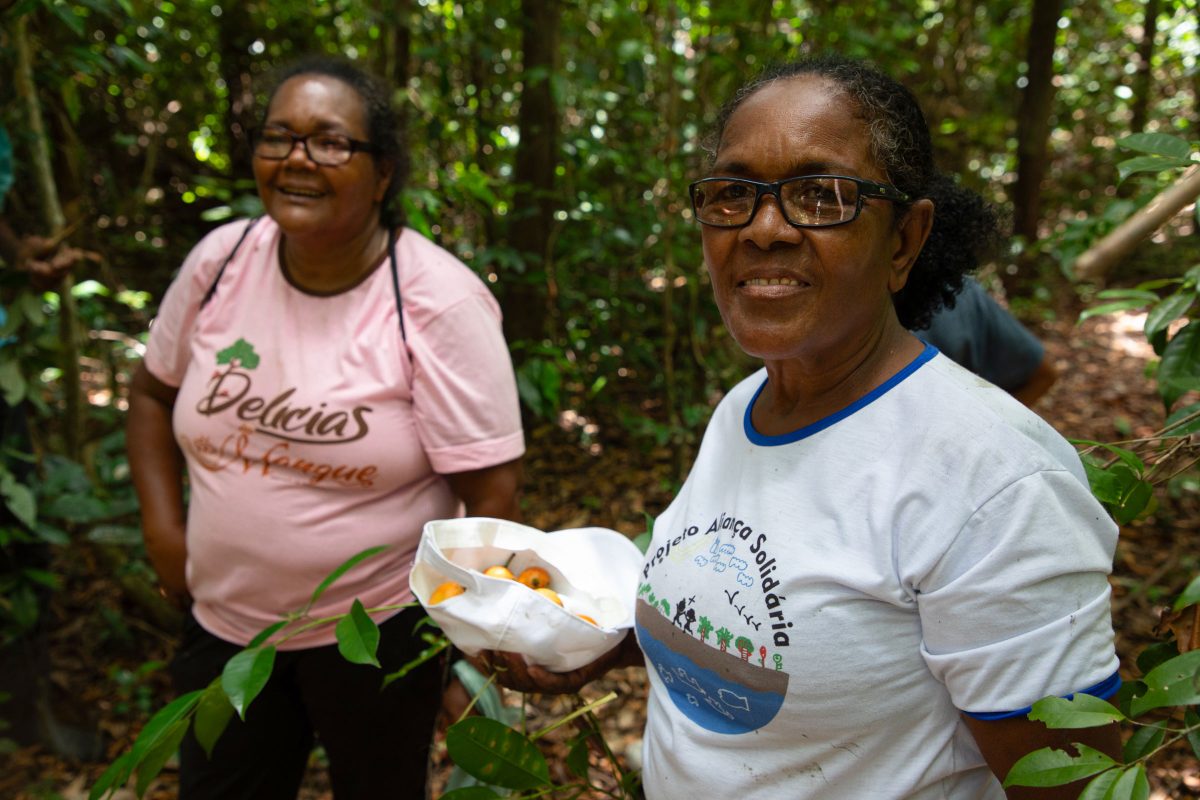
Rita da Conceicao Batista and Maira Cervate Batista Pereira collect fruit on one of the islands of the Cassurubá Extractive Reserve.
When we reach the upper limit of the tideline, the mangroves peter out, and we cross the flat, dry apicum between the mangrove and the scrubby forest beyond. These salt pans are decisive for mangrove survival here and worldwide. As climate change causes sea levels to rise, mangroves retreat into these salty flats. When the flats are developed or altered, mangroves have nowhere to go. Brazil lessened its general protections for apicum ecosystems soon after the Cassurubá Reserve was created, making those within the reserve’s boundaries even more valuable.
Farther inland, we enter a strip of Atlantic Forest in the middle of the island. Rita points out the biribá tree (Rollinia deliciosa), whose wood is used to make the birimbau, a musical instrument played in the Brazilian sport of capoeira. She collects a few small bacupari (Peritassa laevigata) fruits and gives them to us to eat. The taste is a mix between a guava and a lychee.
“I only feel happy when I am inside the mangrove,” Rita says. Coming out on a boat, spending all day hunting in the reserve, and going home with a full sack for dinner is one of the best feelings in the world, she explains. But the land here is hard to work, and money is necessary for basics such as school supplies and medical care.
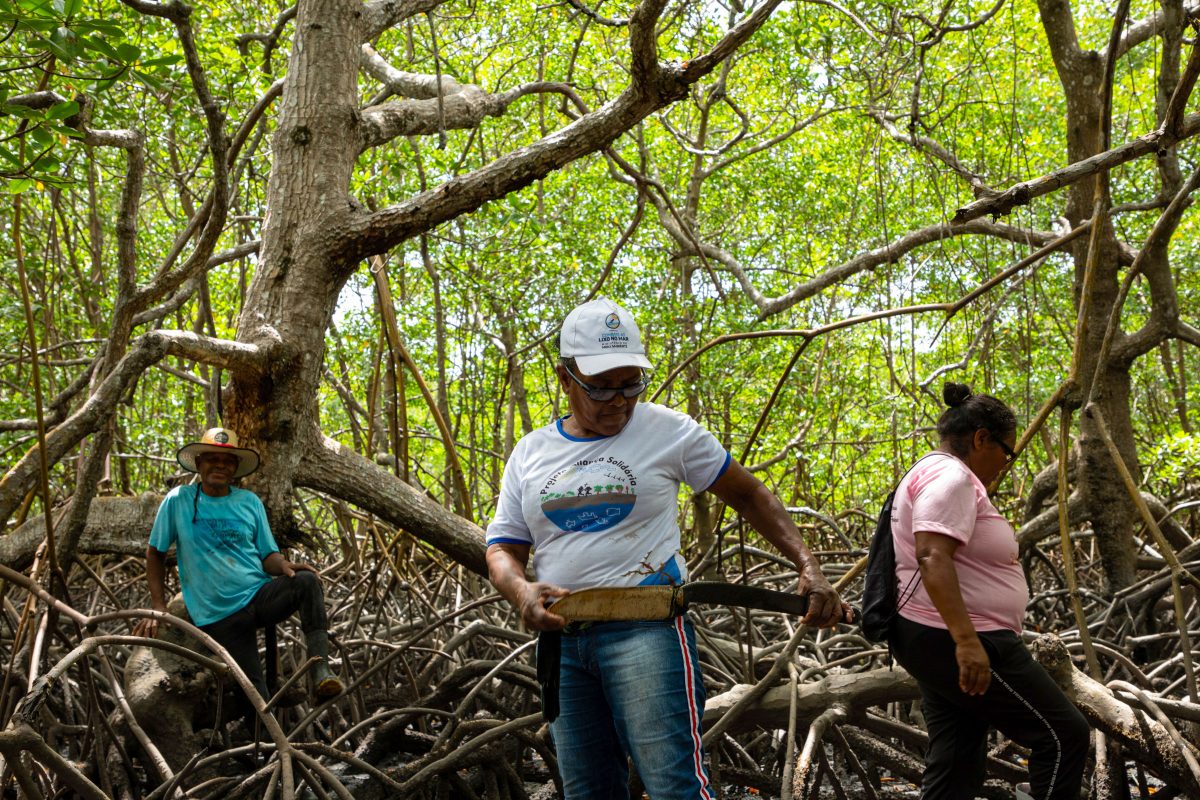
The Residents’ Association of Tapera and Miringaba in Brazil welcomes about 30 tourists into its mangrove forest each month.
The community-based tourism project is meant to address those needs. Before the Residents’ Association of Tapera and Miringaba launched it, tour operators that weren’t connected to the communities would bring visitors to the mangroves and show them around. But the residents didn’t receive anything, says Menezes de Souza.
“When we think about community-based tourism, we don’t think only in terms of profit, of income, but also of the organization of the territory itself, so that other people can’t come in and take advantage of our wealth—the wealth of our culture, our environment, and the people themselves,” he explains. Today the community-based tourism project boasts a few dozen members. The money charged for the tours, which varies depending on the size and purpose of the group, comes out to a per diem rate equivalent to US $25 to $35 for each of the guides, cooks, boat drivers, and administrators. The project also buys much of the food it provides to tourists from cooperatives based in the reserve and offers tours that showcase not only the mangroves but also local artistry, such as basket-weaving.
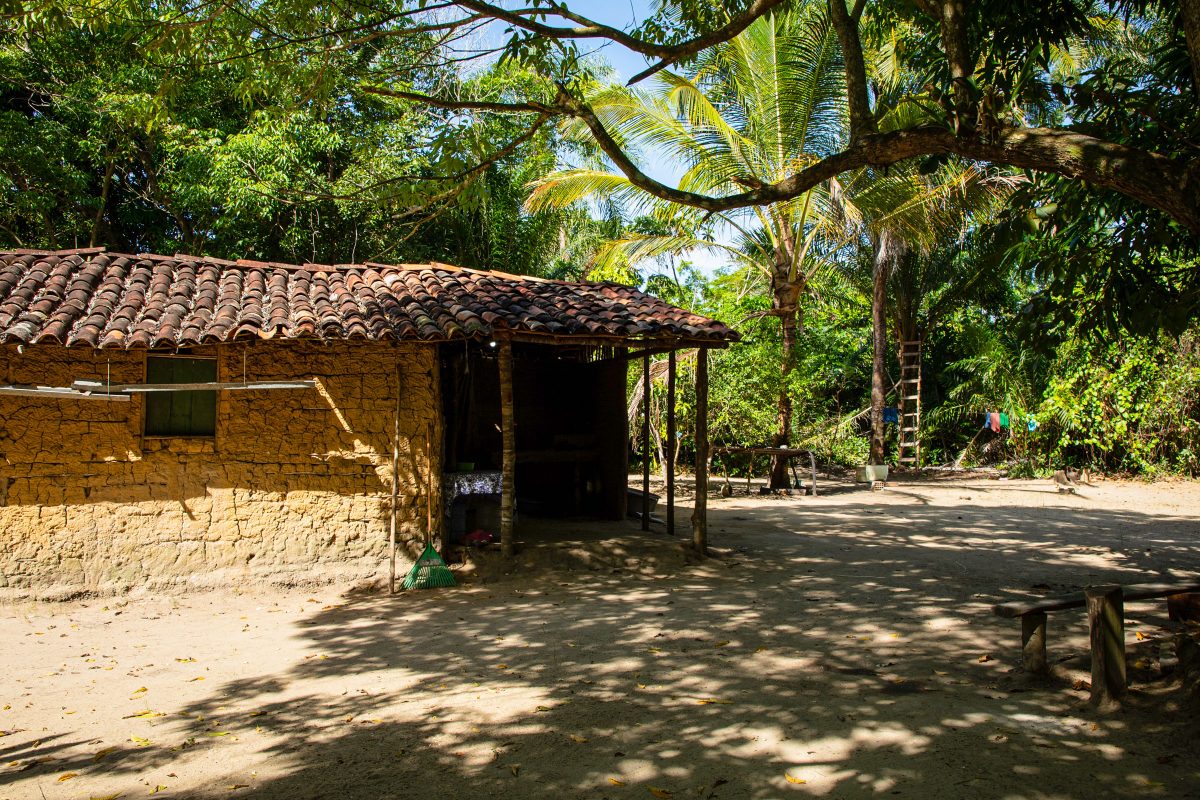
Villages within the Cassurubá Extractive Reserve lack power and plumbing, which makes the area particularly difficult for the elderly and less attractive to the young.
Rita is among the trainees. She’s excited about tourism’s potential, she tells me. “The more people come, the more we will be able to stay here for longer periods of time and improve our life here.”
So far, visitors have been few. Mucking through mangrove forests is harder to sell than swimming among coral reefs or watching whales. On average, around 30 people a month visit the reserve through the community-based tourism project—far fewer than the 100-person limit that the association set to protect the integrity of the mangroves. Menezes de Souza is clear that tourism will only ever be one part of the picture. “We are not going to live off tourism, right? I think that is why the territory is so well preserved—because people don’t channel their efforts into just one product. I think that this guarantees that species we depend on aren’t exposed to too much pressure,” he explains.
Even with few visitors, there are already signs that the project may yield other hoped-for benefits. The mayor of Caravelas has come out to visit the communities in the reserve, Genilson tells me, something that rarely happened before the residents’ association started bringing tourists here. And Tapera and Miringaba, along with several other communities, are now negotiating to build a dock, which would improve access for both tourists and elder community members since getting into a boat currently requires wading into the water and climbing a ladder. There is also talk of an electricity line, a first step to getting internet and better cell phone reception. It’s too early to tell how it will go, but Menezes de Souza attributes all these potential developments to the area’s growing tourism potential.
If the infrastructure is built, it would allow more people to stay in the reserve’s villages to work and maintain their traditions rather than migrate to cities. Keeping the communities connected to the mangroves and using the reserve is crucial for securing their future rights to it and ensuring that ecologically harmful industries can’t move in. Extractive reserves are governed by management plans that the Brazilian government renegotiates every 25 years. If the communities move away, disappear, or stop using resources within the reserve, the lands could technically be designated for other uses. “Development needs to arrive here in a sustainable way that guarantees people’s way of life, but it needs to arrive,” says Menezes de Souza.
As the sun starts to descend, Rita and Genilson hitch a ride back to Caravelas on our boat. Like many aging locals who grew up on this island, they find it difficult to spend extended periods of time here. Genilson looks wistfully back at the mangroves behind us as the sinking sun deepens their green hue. I ask whether he thinks the mangrove forests would have survived without the reserve and without the river people and fishermen to fight for them.
He pauses, as if puzzling over the way I’ve posed the question. “I can’t separate myself from the mangrove,” he finally says. “For me, the mangrove is many things. Many things. To conserve the mangrove is to conserve the person who works in the mangrove. That’s the way it is.”

